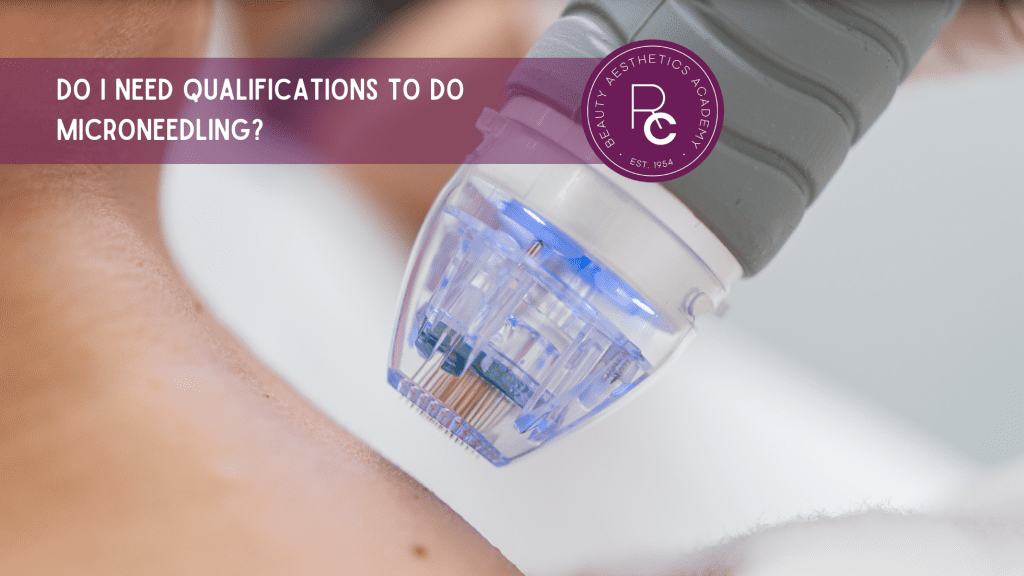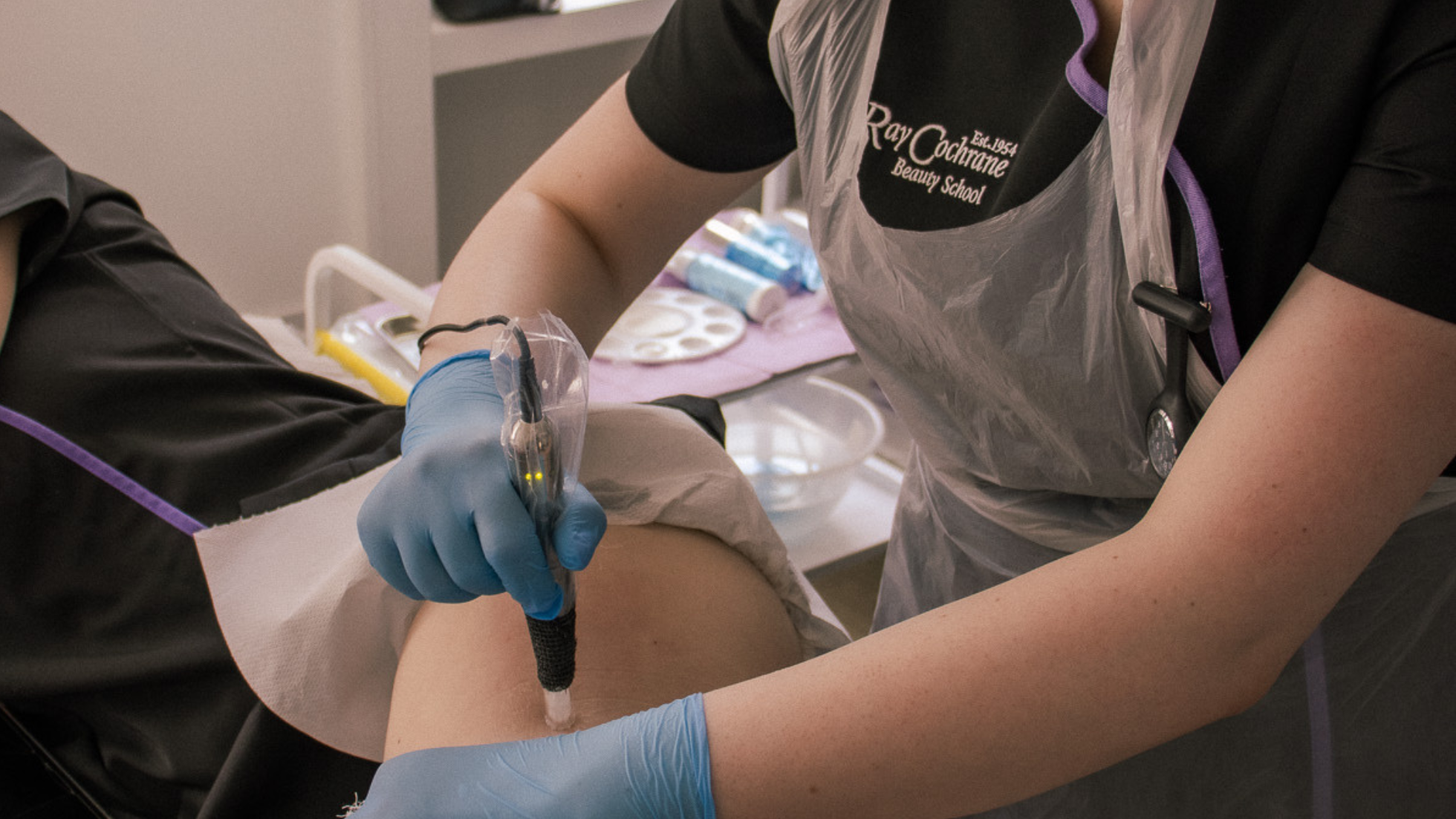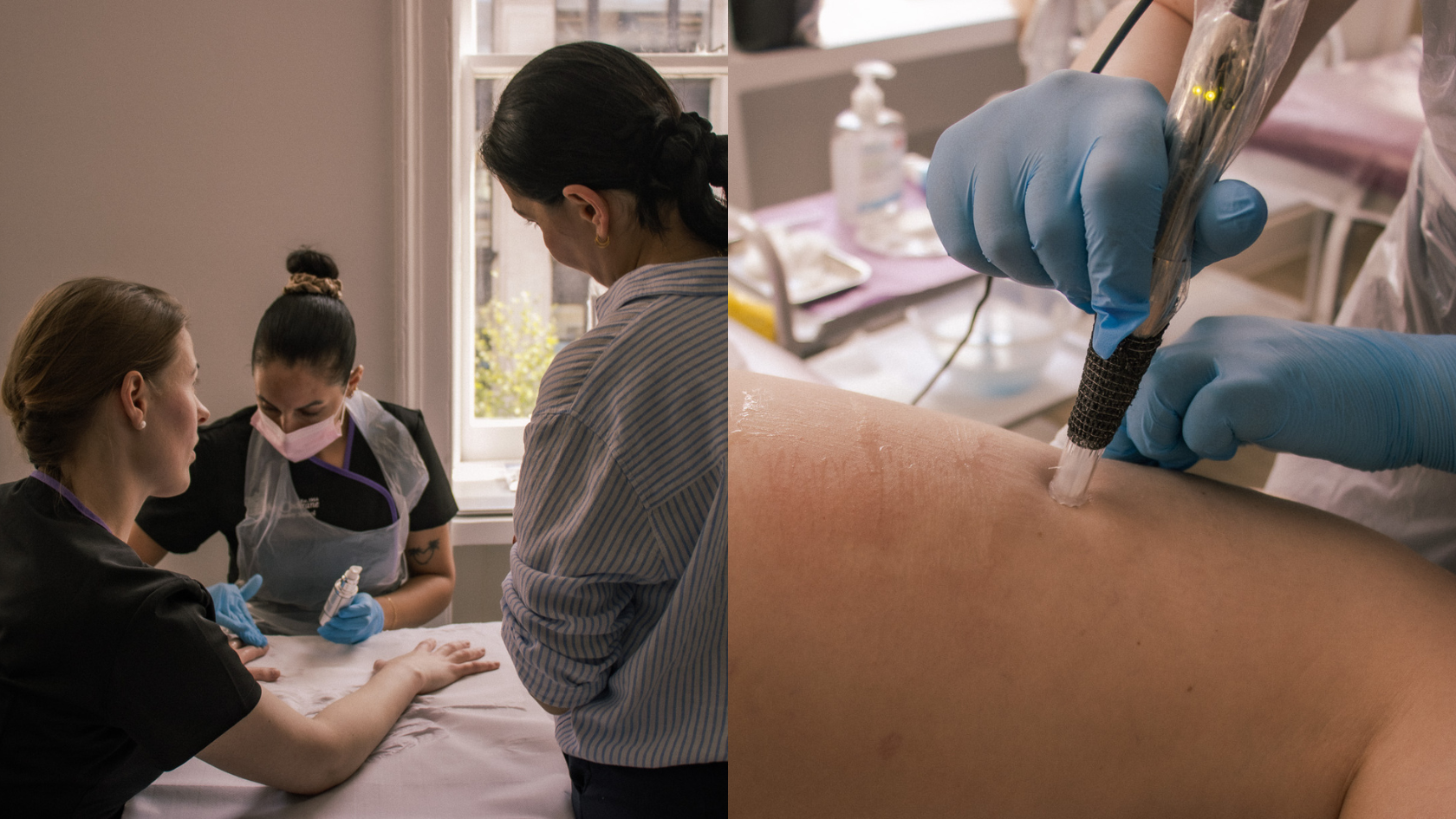
What qualifications do I need to offer microneedling treatment in the UK?
It’s important to note that there are no LEGAL requirements for any formal education or training to work as a practising microneedling therapist in the UK.
This might come as a surprise, but it also highlights the need for government regulation in the aesthetic industry. In the meantime, there are current insurance requirements which require Microneedling technicians to have an accredited Level 3/4 qualification alongside a CPD Microneedling certificate or have completed manufacturer training.
At Ray Cochrane Academy in London, we highly recommend that anyone looking to work successfully as a microneedling therapist in the UK have a VTCT Accredited Level 4 Microneedling qualification.
However, a microneedling CPD course will suffice for those looking to start offering the treatment quickly, as long as they are already Level 3/4 qualified in a relevant beauty aesthetic subject.
In this blog, we emphasise the critical role of proper training and qualifications in ensuring the safety and well-being of your microneedling clients. We’ll discuss the importance of obtaining an accredited qualification, which is essential for becoming a successful microneedling therapist.
All our recommendations are based on government guidance, licensing requirements, and insurance needs. Proper credentials not only enhance your professional credibility but also ensure you provide the highest standard of care, meeting all legal and safety standards in the industry.

What is Microneedling/Skin Needling Treatment?
Microneedling is a non-medical aesthetic procedure that you’ve probably heard of by now. Anyone who’s had the treatment raves about its skin-enhancing benefits, the glow it delivers, and the youthfulness it restores!
We recently wrote an in-depth blog about the science behind microneedling and how the treatment works, which you can read here. To summarise, Microneedling, or collagen induction therapy, uses fine needles to create micro-injuries on the skin, triggering the body’s wound-healing process. This stimulates collagen and elastin production, improving skin texture, firmness, and overall appearance.
The benefits of microneedling for clients include reducing fine lines, wrinkles, acne scars, stretch marks, and hyperpigmentation. It also enhances the absorption of skincare products. The treatment is minimally invasive, safe, and involves minimal downtime.

Do you have to be qualified to do microneedling?
At our beauty aesthetic academy, we frequently stress the importance of accredited aesthetic training, and microneedling is no different. This advanced aesthetic skin treatment involves micro-injuries to the skin, which require a high level of skill and understanding of skin anatomy.
Advanced anatomy and physiology/ health and safety understanding
Qualified microneedling professionals are trained in anatomy and physiology. They recognise contraindications and manage adverse treatment reactions, ensuring their clients’ safety. They also understand the importance of hygiene and the use of professional-grade equipment, which reduces the risk of infections or scarring.
Knowledge of the latest equipment and best practices
Practitioners who have completed their microneedling training will be up to date on the latest advancements and best practices in microneedling, ensuring that they can offer the most effective treatments tailored to their client’s needs.
A professional qualification increases trust with clients
When clients choose a qualified microneedling practitioner, they trust in their expertise to deliver superior results. Investing in comprehensive microneedling training is not just about mastering a technique; it’s about upholding the highest safety standards in skincare.

How deep does professional microneedling go?
Professional microneedling typically uses needles ranging from 0.5mm to 3mm, suitable for deeper penetration and more effective results. 2mm to 3mm is usually reserved for microneedling body treatments, whilst 0.5mm to 2mm is safe for facial use. In contrast, home devices use shorter needles, usually 0.25mm to 0.5mm, for user safety and surface-level treatments.
Health Education England (HEE) reviewed the qualifications required to deliver non-surgical cosmetic interventions. For microneedling, HEE recommends a Level 4 qualification for depths of 0.5mm, a Level 5 qualification for depths up to 1.0mm and a Level 6 qualification for depths up to 1.5mm.
Insurance providers also follow these recommendations and require practitioners to have a Level 3 beauty qualification and relevant microneedling training to provide public liability insurance. Your insurance provider will likely want to know the depth you intend to deliver and require you to have higher qualifications to be adequately covered.
Is a microneedling qualification worth it?
100% YES! Microneedling improves the skin’s appearance significantly, making it an excellent choice for clients and your business. Here are five reasons why you should consider training in microneedling this year!
1) It is a financially rewarding career
Before training in any skill or speciality, it is normal to want to understand your earning potential. After all, your job is responsible for providing your livelihood.
Microneedling treatment continues to grow in popularity, increasing the demand for skilled professionals. With the ability to treat various skin concerns such as wrinkles and scars to hyperpigmentation, skin needling treatments come with a premium price tag. So…
How much do you make microneedling?
As a microneedling specialist in the UK, you can expect to make an average of £25,000 to £40,000. This number can increase if you offer other beauty and aesthetic treatments alongside microneedling.
Microneedling specialists can also make more money by selling clients aftercare treatments to take home and regular maintenance treatments such as facials.
2) It provides high client satisfaction
One of the benefits of training in professional microneedling is the high level of client satisfaction the treatment provides. Despite being a minimally invasive procedure, clients often see significant improvement in skin texture, tone and overall appearance after just a few sessions.
As a qualified microneedling therapist, you will have the skills to deliver these satisfying results that a less qualified practitioner wouldn’t be able to.
The excellent results will lead to repeat business and positive referrals to friends and family. After all, happy clients are more likely to return for additional treatments and recommend your services to others, enhancing your business’s reputation.
3) Entrepreneurial Opportunities
A microneedling qualification can be an asset for therapists looking to start their own beauty, aesthetic, or skincare business. Whether you’re looking to open your own clinic, provide mobile treatments, or incorporate microneedling into your existing business, the opportunities are vast with this popular treatment.
The expertise gained through proper training will allow you to develop personalised treatment plans that combine other aesthetic therapies with microneedling, set competitive pricing, and create a standout brand!
4) Advance Your Skills
Pursuing a microneedling qualification is an excellent way to advance your skills and knowledge in the aesthetics field. As an advanced aesthetic qualification, the training goes beyond basic techniques, providing an in-depth understanding of skin anatomy, wound healing, and safe practices.
Advanced skills lead to better client outcomes, increased satisfaction, and a stronger professional reputation.
5) Prepare for future government regulations and licensing requirements
The UK government recently announced they are investigating unregulated aesthetic treatments to ensure consistent quality across these advanced treatments. Depending on the outcome of this investigation, anyone carrying out aesthetic treatments will likely need an accredited qualification to work legally.
Based on her many years of experience, our school’s education director, Eleonora Androva, believes that microneedling treatments over 1mm will need a regulated qualification if the licensing requirement is passed.
Gaining a recognised microneedling qualification will ensure that if a government licensing framework is introduced, you can continue to work freely as a microneedling therapist.
Proper certification provides peace of mind, knowing you are fully covered in any complications or issues.

How do you get microneedling qualified?
Now we’ve explained why you should get a microneedling qualification, let’s get into the hows of becoming qualified. There are two routes that we recommend to learners looking to complete microneedling training:
You can complete an accredited Level 4 Microneedling course or a CPD Microneedling course.
What is a CPD Microneedling course?
A Continuing Professional Development (CPD) Microneedling course is not an accredited qualification. Instead, it is designed for beauty and aesthetic professionals who want to add microneedling to their treatment offerings quickly.
The course can be completed in just one day. Students will learn essential theory knowledge and practical skills to perform microneedling treatments safely and effectively.
A Microneedling CPD course is suitable for individuals already Level 3 or Level 4 qualified in a related beauty or aesthetic vocation. It is NOT ideal for those with no previous beauty experience or qualifications.
While a CPD course can be sufficient for starting microneedling treatments, it doesn’t offer the comprehensive training of a higher-level accredited course.
What is the VTCT Level 4 Microneedling course?
The VTCT Level 4 Skin Needling course is a fully accredited 12-week course that offers in-depth training on microneedling techniques, skin anatomy, and safety protocols. As the course is more in-depth, students will learn advanced topics such as the different needle sizes, contraindications, client consultation, and aftercare advice.
On the Level 4 Microneeding course, learners will have more time to complete practical studies on live models under the supervision of an experienced tutor. An extended learning period ensures that students can comfortably and safely perform microneedling treatments professionally by the end of the course.
Completing this course can enhance the learner’s credibility, meet government and insurance requirements, and provide clients with a higher standard of care.

Which microneedling course is most suitable for me – CPD or Level 4?
Choosing the right microneedling course depends on your qualifications, career goals, and desired level of expertise.
If you are already a Level 3 or Level 4 qualified beauty or aesthetic professional, who wants to test out the treatment and see if it is worth the investment before completing a fully accredited training, a Microneedling CPD course would be sufficient.
However, if you want to gain comprehensive knowledge, meet the highest standards of practice in the Microneedling industry, and ensure full compliance with potential future regulations and meet current insurance requirements, the VTCT Level 4 Microneedling course is the better option.
For the students who have completed the CPD Microneedling course and want to upgrade to the VTCT Level 4, we are able to apply recognition of the previous learning (RPL).
What qualifications do I need to do Microneedling as a beginner?
Are you interested in delivering microneedling aesthetic treatments but have no prior beauty or aesthetic training? To start microneedling as a beginner, you must complete a relevant beauty level 2 and 3 qualification. We recommend either the VTCT Level 2 Facial and Skincare or the VTCT Level 2 Beauty Therapy course. Once you have completed either of those, you can move on to the VTCT Level 3 Facial Electrical or Level 3 Beauty Therapy, either of which enables you to progress to a Level 4 advanced course to train in Microneedling.
Why choose Ray Cochrane to complete your microneedling training?
Ray Cochrane Beauty Aesthetic Academy is the leading beauty aesthetic academy in London. We are the go-to training centre for comprehensive, high-quality training courses, and our microneedling training is no different!
Our academy boasts experienced tutors who bring real-world expertise to their teaching, ensuring students receive the best and most up-to-date education.
Furthermore, our academy’s central London location provides easy access from around the country and the opportunity to learn in a vibrant, professional setting with modern facilities.
By choosing Ray Cochrane Beauty Aesthetic Academy, our learners invest in a future-proof education that equips them with the skills and qualifications needed to succeed in the competitive field of aesthetics!
If you want to learn more about completing your microneedling training with us, please contact us today! Our training academy is open from 9 a.m. to 5 p.m., Monday through Friday. You can reach us by phone at 020 3856 8886 or email us at admission@raycochrane.studiocoact.co.uk.

Microneedling Qualifications Frequently Asked Questions
What certification do you need for microneedling?
Currently, there are no certification requirements for delivering microneedling treatments. However, we expect that the government will enforce licencing requirements in the future, which will require microneedling practitioners to have a regulated training qualification.
How long does it take to learn microneedling?
To complete a regulated training course, learners must complete 170 qualification hours with 123 guided learning hours. Our VTCT Level 4 Skin Needling comprehensive training course runs for 12 weeks, one day a week. The microneedling CPD course, which isn’t an accredited qualification, can be completed in just one day and covers the basics of microneedling.
Do I need a licence for microneedling?
No, you do not need a licence to work as a microneedling practitioner in the UK. However, if that were to change, you would require a Level 4 or Level 5 microneedling qualification to get the licence, as with other advanced aesthetic treatments.
Can I learn microneedling online?
Whilst some courses promise to teach you everything you need to know about microneedling online, we firmly believe this is impossible. A big part of all microneedling courses is the practical training and practical examination, where students carry out microneedling treatments on a live model. During this practical training, the experienced tutor will correct their application and ensure they are ready to work independently.
What do I need to start microneedling?
To start microneedling professionally, you need an interest in aesthetic treatments, a steady hand, and a can-do attitude! Microneedling is a great place to start if you want to introduce advanced aesthetic treatments to your clients.
